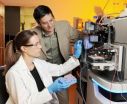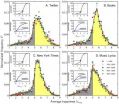(Press-News.org) Researchers from the Georgia Institute of Technology and the Centers for Disease Control and Prevention (CDC) have developed a new laboratory test that can rapidly identify the bacterium responsible for staph infections. This new test takes advantage of unique isotopic labeling combined with specific bacteriophage amplification to rapidly identify Staphylococcus aureus.
Quickly and accurately detecting infections caused by S. aureus is critical because the pathogenic bacterium causes a broad spectrum of infections, ranging from acute to chronic disease, which need to be treated in a prompt manner with the correct antibiotic.
The test uses mass spectrometry to quantify the number of S. aureus organisms in a large number of samples in just a few hours, compared to a day or two for culturing techniques typically used to detect this bacterium.
"Our method for detecting staph infections using mass spectrometry will be valuable in a variety of situations, but will be crucial when a large number of people need to be tested very quickly, which will ultimately improve treatment," said Facundo Fernández, an associate professor in the Georgia Tech School of Chemistry and Biochemistry.
Details of the new staph infection detection method were published in the January issue of the journal Molecular and Cellular Proteomics. Partial funding for this research was provided by 3M and the CDC/Georgia Tech seed award program.
Fernández together with Carrie Pierce, Jon Rees and John Barr from the CDC's Division of Laboratory Sciences created this test.
"The simplicity of sample preparation, the low cost of required reagents and the increased availability of mass spectrometers in clinical laboratories make this new method a cost-effective way to rapidly and effectively detect staph infections, which must be treated quickly to prevent spread of the disease," explained Pierce, a research chemist at the CDC who also worked on the project as a graduate student at Georgia Tech.
To run their test, the researchers first inject a known amount of bacteriophage labeled with nitrogen-15 into a sample. The phages -- which are viruses that infect bacteria -- infect only live S. aureus cells, which then multiply and amplify the phage signal. Following a two-hour incubation, the researchers break up proteins from the phage shell into component peptides using a trypsin digest technique.
Then they analyze the sample using liquid chromatography with tandem mass spectrometric detection. By detecting peptides from the protein shell of the phage, the researchers can measure the concentration of S. aureus in the sample.
"The strength of this technique is coupling a well-characterized method for identifying bacteria with a modern detection device, such as a mass spectrometer," said Barr, biological mass spectrometry lead in the CDC's Division of Laboratory Sciences. "By labeling input phage with heavy nitrogen isotopes, we were able to use mass spectrometry to effectively distinguish between the parent and progeny phage, thus enhancing the selectivity of the method."
This prototype mass spectrometry-based technique has been optimized to detect low concentrations of bacteria that should allow clinicians to diagnose staph infections without the need for a significant culture period. Coupled with standard laboratory robotics, the test will reduce manual labor and subjective interpretation of results inherent in traditional techniques.
"An exciting aspect of this phage method is that with small modifications to the procedures, resistance and susceptibility to a number of different antibiotics can be determined in addition to bacterial identification," said Rees. "This additional piece of information may be the key to wide acceptance of the method."
INFORMATION:
New laboratory method uses mass spectrometry to rapidly detect staph infections
2012-01-13
ELSE PRESS RELEASES FROM THIS DATE:
Hydrogen advances graphene use
2012-01-13
Physicists at Linköping University have shown that a dose of hydrogen or helium can render the "super material" graphene even more useful.
Graphene has engendered high expectations whereof its extreme properties depend on the fact that it consists of a single sheet of carbon atoms. However the attraction forces between the atoms cause the sheets to be drawn to each other. One solution is to add atomic hydrogen between the layers.
Presented in the eminent journal Physical Review A, the researchers' calculations show that the hydrogen at a given concentration affects ...
Thousands of seniors lack access to lifesaving organs, despite survival benefit
2012-01-13
Thousands more American senior citizens with kidney disease are good candidates for transplants and could get them if physicians would get past outdated medical biases and put them on transplant waiting lists, according to a new study by Johns Hopkins researchers.
The Hopkins investigators estimate that between 1999 and 2006, roughly 9,000 adults over 65 would have been "excellent" transplant candidates and approximately 40,000 more older adults would have been "good" candidates for new kidneys. None, however, were given the chance.
"Doctors routinely believe and tell ...
LSUHSC research identifies 'bath salts' as new source of flesh-eating infection
2012-01-13
New Orleans, LA – A study led by Russell R. Russo, MD, a third-year Orthopaedic Surgery resident at LSU Health Sciences Center New Orleans School of Medicine, has identified a new source of life-threatening necrotizing fasciitis – "bath salts." The study, describing the first known case of necrotizing fasciitis from an intramuscular injection of the street drug known as "bath salts," is published in the January 2012 issue of Orthopedics, now available online.
Necrotizing fasciitis is an orthopedic emergency. The ability to quickly and accurately diagnose this rapidly ...
First detailed data of risk of using Rasilez with certain blood pressure-lowering drugs
2012-01-13
TORONTO, Ont., Jan. 12, 2012—Researchers at St. Michael's Hospital have published the first detailed figures showing the risk of using the prescription drug Rasilez in combination with certain other blood pressure-lowering medications.
The pharmaceutical company Novartis terminated a large, international clinical trial of the drug last month after finding an increased incidence after 18-24 months of non-fatal strokes, renal complications, high levels of potassium in the blood and low blood pressure.
As a result, Health Canada said on Dec. 22 that it would review the ...
New culprit discovered in T-cell acute lymphoblastic leukemia
2012-01-13
A new study published in the journal Nature Medicine by NYU Cancer Institute researchers, shows how the cancer causing gene Notch, in combination with a mutated Polycomb Repressive Complex 2 (PRC2) protein complex, work together to cause T- cell acute lymphoblastic leukemia (T-ALL).
T-ALL is an aggressive blood cancer, predominately diagnosed in children. It occurs when one lymphoblast, an immature white blood cell, turns malignant, multiplying uncontrollably and spreading rapidly throughout the body. If left untreated, the disease can be fatal in a few weeks. Cancer-causing ...
Researchers: Honeybee deaths linked to seed insecticide exposure
2012-01-13
WEST LAFAYETTE, Ind. - Honeybee populations have been in serious decline for years, and Purdue University scientists may have identified one of the factors that cause bee deaths around agricultural fields.
Analyses of bees found dead in and around hives from several apiaries over two years in Indiana showed the presence of neonicotinoid insecticides, which are commonly used to coat corn and soybean seeds before planting. The research showed that those insecticides were present at high concentrations in waste talc that is exhausted from farm machinery during planting.
The ...
We may be less happy, but our language isn't
2012-01-13
"If it bleeds, it leads," goes the cynical saying with television and newspaper editors. In other words, most news is bad news and the worst news gets the big story on the front page.
So one might expect the New York Times to contain, on average, more negative and unhappy types of words — like "war," " funeral," "cancer," "murder" — than positive, happy ones — like "love," "peace" and "hero."
Or take Twitter. A popular image of what people tweet about may contain a lot of complaints about bad days, worse coffee, busted relationships and lousy sitcoms. Again, it might ...
Researchers find new, noninvasive way to identify lymph node metastasis
2012-01-13
TAMPA, Fla. (Jan. 12, 2012) – Using two cell surface markers found to be highly expressed in breast cancer lymph node metastases, researchers at Moffitt Cancer Center, working with colleagues at other institutions, have developed targeted, fluorescent molecular imaging probes that can non-invasively detect breast cancer lymph node metastases. The new procedure could spare breast cancer patients invasive and unreliable sentinel lymph node (SLN) biopsies and surgery-associated negative side effects.
Their study was published in a recent issue of Clinical Cancer Research ...
Scientists learn how stem cell implants help heal traumatic brain injury
2012-01-13
For years, researchers seeking new therapies for traumatic brain injury have been tantalized by the results of animal experiments with stem cells. In numerous studies, stem cell implantation has substantially improved brain function in experimental animals with brain trauma. But just how these improvements occur has remained a mystery.
Now, an important part of this puzzle has been pieced together by researchers at the University of Texas Medical Branch at Galveston. In experiments with both laboratory rats and an apparatus that enabled them to simulate the impact of ...
Explosives and fish are traced with chemical tags
2012-01-13
Researchers at the University of Oviedo (Spain) have come up with a way of tagging gunpowder which allows its illegal use to be detected even after it has been detonated. Based on the addition of isotopes, the technique can also be used to track and differentiate between wild fish and those from a fish farm, such as trout and salmon.
A new method for tagging and identifying objects, substances and living beings has just been presented in this month's issue of the Analytical Chemistry journal. Its creators are scientists at the University of Oviedo who have patented the ...


